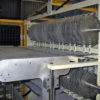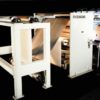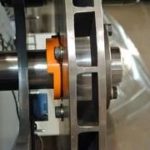All profitable businesses start with a good idea.
A few years ago, James E. Hammer, President & CEO of Rochester, NY-based Hammer Lithograph, recognized the need for a paper converting operation that would sheet and warehouse paper for Hammer Lithograph and, at the same time, develop an independent regional customer base of its own. The resulting division, J. MacKenzie, Ltd., opened in 1994 under the leadership of plant manager, Steve Ray.
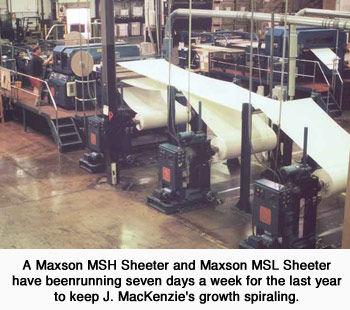 Ray was also convinced that a sheeting operation would give Hammer Lithograph more control over quality, service, delivery and cost. “As an advocate of just-in-time, we saw an advantage in sheeting from roll inventory to shorten manufacturing turnaround times,” says Ray. “When sheeted stock was ordered from mills, the wait was often a minimum of five days. At J. MacKenzie we can turn around sheeted stock in 24 – 48 hours and still adhere to the exacting quality standards we’ve established.”
Ray was also convinced that a sheeting operation would give Hammer Lithograph more control over quality, service, delivery and cost. “As an advocate of just-in-time, we saw an advantage in sheeting from roll inventory to shorten manufacturing turnaround times,” says Ray. “When sheeted stock was ordered from mills, the wait was often a minimum of five days. At J. MacKenzie we can turn around sheeted stock in 24 – 48 hours and still adhere to the exacting quality standards we’ve established.”
Hammer Lithograph is a packaging printer which specializes in multi-color, high quality sheet fed offset labels for food and beverage companies such as Poland Springs Water, Mott’s USA Products and other private label brands. The company, which recently relocated to a new 90,000 sq. ft. state-of-the-art corporate headquarters and manufacturing facility, records annual sales in excess of $35 million.
Hammer Lithograph today represents only 30 – 40% of total sales since J. MacKenzie’s launch five years ago. J. MacKenzie’s annual sales have doubled in the last two years alone. “We now occupy 57,000 sq. ft. of production and warehouse space and continue to expand. We have a 60 railroad car capability that is used to ship rolls of paper, but can also serve as additional warehouse space,” explains Ray. “Because we have material inventoried for immediate use, we can turnaround an order in eight to twenty four hours. We also warehouse stock for customers. We have as much as 30 truckloads warehoused at the moment, representing a wide variety of paper mills.”
After reviewing several sheeter designs, the company chose the MSL sheeter from Maxson Automatic Machinery Co. According to Ray, “The MSL sheeter met our requirements for accuracy while offering the flexibility to sheet a mix of paper and board.” They have been so pleased with the sheeter’s performance, a second one was ordered when they couldn’t keep up with increasing business.
The original MSL sheeter is capable of sheeting rolls up to 57 in. wide and handles a broad range of materials, including coated-one-side, coated-two-side, and offset paper grades in basis weights ranging from 30# to 100# at speeds up to 700 fpm. The MSL sheeter will cleanly cut solid bleached sulfate board up to 0.28 pt. A dual-motor drive provides sheet length accuracy of ±0.030 on three roll stands, regardless of line speed or cutoff. Sheet length changes are actuated in minutes by means of a simple keypad entry.
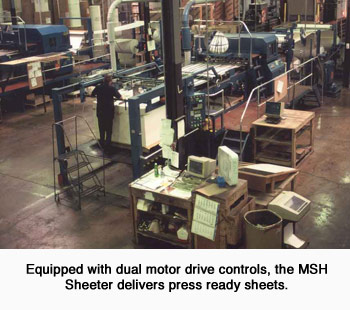 “An opportunity developed to do additional contract sheeting to convert board grades in 8, 10, 12, 16, 18 & 24 pt., 50% in heavier grades and 50% in lighter grades,” says Ray. The Maxson MSH sheeter was considered to be the ideal second sheeter to handle increased production capacity.
“An opportunity developed to do additional contract sheeting to convert board grades in 8, 10, 12, 16, 18 & 24 pt., 50% in heavier grades and 50% in lighter grades,” says Ray. The Maxson MSH sheeter was considered to be the ideal second sheeter to handle increased production capacity.
The new MSH sheeter is a workhorse. Like the MSL sheeter, the MSH is also equipped with the patented Airfoil Overlap System that ensures jam-free conveyance of sheets to the stacker. The MSH is capable of sheeting 1200 fpm and has greater knife loading for handling multi-web runs of paper as well as board grades. “We find the knife to be very rugged. It provides a cleaner cut, requires less adjustment and doesn’t flex,” Ray asserts. “Incorporation of an adjustable doctor board before the knife is another feature that assists in providing quality operation.”
Equipped with a dual motor drive, both the MSL and the MSH maintain a sheet length accuracy of ±0.015″ and ±0.020″ squareness cutoff regardless of line speed. Each sheeter is equipped with two or three shaftless Citation roll stands, which handles rolls up to 6,000 pounds and a diameter up to 72 inches. The Citation is designed for speedy roll changes. In just a few minutes a single operator can roll material in place between two posts, chuck the rolls and raise them into place. A variety of sheet widths are possible since both machines are equipped with easily adjustable air-loaded slitter-rig assemblies.
Ray comments, “We keep the MSL sheeter busy at least 2-3 weeks a month on lighter weight materials. We reserve the MSH for multi-web runs of heavier stock even though it too runs lightweight materials perfectly. We’re sheeting three rolls of 60# wet strength paper for labels with waste as low as 3-6%. Plus, we’re sheeting three rolls of metallized coated paper, adhesive cloth, and 20 pt. Vinyl as well as C1S and SBS grades. We’re running as much as 132,000 pounds of virgin paper with three 4-man shifts, 7 days a week over two machines.” Ray went on to say, “We’ve been running non-stop for over twelve months.”
J. MacKenzie can satisfy every customer’s needs due to the Maxson sheeter’s flexibility and ease of set up. An average run is between 2,000 to 3,000 sheets. But J. MacKenzie can accommodate runs from 1,000 up to 1,000,000 sheets.
To maintain that kind of production requires an aggressive maintenance plan. “The MSL sheeter’s knives are replaced every three weeks; the MSH sheeter’s, every four weeks. The slitter blades are changed every day and the bottom bands are changed each time the knives are replaced,” Ray stated. “We have also put in place state-of-the-art quality control devices including bar-coding equipment that tracks TAPPI numbers enabling us to have constant inventory control. A system has been put in place to check skids of sheeted material for consistent squareness and meticulous log records are kept.”
Up until now, the success of J. MacKenzie has been achieved without the assistance of a sales staff. To guarantee continued growth, however, two salespeople have been added as business is expected to double within the next three to five years and expand beyond its present 500-mile radius.
J. MacKenzie is proof positive that a good idea can turn into a great business.
Reprinted from The Sheeting Monitor, December 1999


